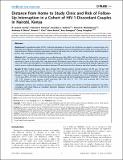| dc.contributor.author | Conley, N. Jeanne | |
| dc.contributor.author | Pavlinac, Patricia B. | |
| dc.contributor.author | Guthrie, Brandon L. | |
| dc.contributor.author | Mackelprang, Romel D. | |
| dc.contributor.author | Muiru, Anthony Ndichu | |
| dc.contributor.author | Choi, Robert Y. | |
| dc.contributor.author | Bosire, Rose | |
| dc.contributor.author | Gatuguta, Ann | |
| dc.contributor.author | Farquhar, Carey | |
| dc.date.accessioned | 2013-03-29T18:34:04Z | |
| dc.date.issued | 2012 | |
| dc.identifier.citation | Conley, N. Jeanne, Patricia B. Pavlinac, Brandon L. Guthrie, Romel D. Mackelprang, Anthony N. Muiru, Robert Y. Choi, Rose Bosire, Ann Gatuguta, and Carey Farquhar. 2012. Distance from home to study clinic and risk of follow-up interruption in a cohort of HIV-1-discordant couples in Nairobi, Kenya. PLoS ONE 7(8): e43138. | en_US |
| dc.identifier.issn | 1932-6203 | en_US |
| dc.identifier.uri | http://nrs.harvard.edu/urn-3:HUL.InstRepos:10476711 | |
| dc.description.abstract | Background: Longitudinal studies of HIV-1-infected individuals or those at risk of infection are subject to missed study visits that may have negative consequences on the care of participants and can jeopardize study validity due to bias and loss of statistical power. Distance between participant residence and study clinic, as well as other socioeconomic and demographic factors, may contribute to interruptions in patient follow-up. Methods: HIV-1-serodiscordant couples were enrolled between May 2007 and October 2009 and followed for two years in Nairobi, Kenya. At baseline, demographic and home location information was collected and linear distance from each participant’s home to the study clinic was determined. Participants were asked to return to the study clinic for quarterly visits, with follow-up interruptions (FUI) defined as missing two consecutive visits. Cox proportional hazards regression was used to assess crude and adjusted associations between FUI and home-to-clinic distance, and other baseline characteristics. Results: Of 469 enrolled couples, 64% had a female HIV-1-infected partner. Overall incidence of FUI was 13.4 per 100 person-years (PY), with lower incidence of FUI in HIV-1-infected (10.8 per 100 PY) versus -uninfected individuals (16.1 per 100 PY) (hazard ratio [HR] = 0.66; 95% confidence interval [CI]: 0.50, 0.88). Among HIV-1-infected participants, those living between 5 and 10 kilometers (km) from the study clinic had a two-fold increased rate of FUI compared to those living <5 km away (HR = 2.17; 95% CI: 1.09, 4.34). Other factors associated with FUI included paying higher rent (HR = 1.67; 95% CI: 1.05, 2.65), having at least primary school education (HR = 1.96; 95% CI: 1.02, 3.70), and increased HIV-1 viral load (HR = 1.23 per log10 increase; 95% CI: 1.01, 1.51). Conclusions: Home-to-clinic distance, indicators of socioeconomic status, and markers of disease progression may affect compliance with study follow-up schedules. Retention strategies should focus on participants at greatest risk of FUI to ensure study validity. | en_US |
| dc.language.iso | en_US | en_US |
| dc.publisher | Public Library of Science | en_US |
| dc.relation.isversionof | doi:10.1371/journal.pone.0043138 | en_US |
| dc.relation.hasversion | http://www.ncbi.nlm.nih.gov/pmc/articles/PMC3428010/pdf/ | en_US |
| dash.license | LAA | |
| dc.subject | Medicine | en_US |
| dc.subject | Epidemiology | en_US |
| dc.subject | Epidemiological Methods | en_US |
| dc.subject | Infectious Disease Epidemiology | en_US |
| dc.subject | Spatial Epidemiology | en_US |
| dc.subject | Global Health | en_US |
| dc.subject | Infectious Diseases | en_US |
| dc.subject | Viral Diseases | en_US |
| dc.subject | HIV | en_US |
| dc.subject | HIV epidemiology | en_US |
| dc.subject | HIV prevention | en_US |
| dc.subject | Non-Clinical Medicine | en_US |
| dc.subject | Health Care Policy | en_US |
| dc.subject | Health Education and Awareness | en_US |
| dc.subject | Health Informatics | en_US |
| dc.subject | Public Health | en_US |
| dc.subject | Behavioral and Social Aspects of Health | en_US |
| dc.title | Distance from Home to Study Clinic and Risk of Follow-Up Interruption in a Cohort of HIV-1-Discordant Couples in Nairobi, Kenya | en_US |
| dc.type | Journal Article | en_US |
| dc.description.version | Version of Record | en_US |
| dc.relation.journal | PLoS ONE | en_US |
| dash.depositing.author | Muiru, Anthony Ndichu | |
| dc.date.available | 2013-03-29T18:34:04Z | |
| dc.identifier.doi | 10.1371/journal.pone.0043138 | * |
| dash.contributor.affiliated | Muiru, Anthony Ndichu | |


